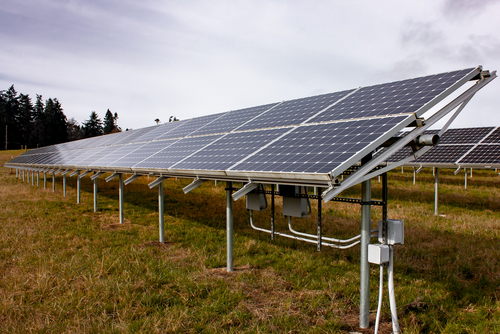
By Jim Newcomer, LOSN
I’m a subscriber to community solar power, so I warn you that I’m writing with a bias: I love it. But wait, there’s more: I’m part of an experiment that could increase our nation’s vegetable supply. What?
First, here’s my experience with the program. About two years ago my wife and I, who rent our home, wanted to access electricity that was procured from clean, renewable sources that would produce few greenhouse gas emissions – that is, not from coal or natural gas. Since we could not erect solar panels on our landlord’s roof, we signed up for Community Solar Power through the Oregon Community Solar Project.
At first we were disappointed – all their available solar farms were fully subscribed, and we were put on a waiting list. After a couple of months, though, a new project opened near us, and they accepted us as a subscriber. Immediately we began to receive electricity from it.
Nothing changed at our house. No new wires were connected; no adapters were required. We still got our power through those same PGE lines along our street, but PGE was receiving electrons from our solar farm and providing the equivalent flow of electrons to us from their power line. (Important concept – equivalent flow. It means we do not actually receive electrons from our solar farm into our home!)
We were informed that a company named Arcadia, a national firm that builds and manages solar farms in several states, had invested in our local solar farm and was managing our connection from there to PGE. We receive regular updates from them and we still, just as before, receive a monthly bill from PGE that oddly enough contains no mention of Arcadia or, for that matter, our connection to solar. We now receive normal electric service round the clock, of course, rain or shine, and we also experience all the power outages that occur to PGE customers. But I get a little rush of pleasure every time I think of our lights being powered by our solar farm!
I’ll add that in our experience the attraction of saving money on our monthly electric bill is virtually negligible – maybe $5 a month. Our satisfaction comes from knowing that despite renting our home, when we turn on the lights our energy comes directly from the sun instead of from a coal-fired generator or a natural gas turbine. We can say, just as if we had solar panels on our roof, most of our electricity is now clean and renewable.
Now here’s how we were surprised: Solar Harvest, the solar farm that produces our energy, is in a six-acre field not far from the airport in Aurora, down I-5 less than ten miles from our home. Then we discovered a second surprise: the Solar Harvest Farm near Aurora is operated by Oregon State University’s College of Agriculture as an experimental marriage of solar panels and farming.
There, under the rows of photovoltaic (PV) panels, they are planting shade-tolerant crops such as alfalfa, arugula, beets, bok choy, cabbage, carrots, chard, garlic, onions, parsley, radish, spinach, sweet potato, turnips and yams. To make it work, they have even enabled some of the solar panels to tilt up to allow tractors to pass.
Their purpose? To see if growing things under and among solar panels would increase production by cooling the ground in hot summer months and saving water. And it does! In their report evaluating the results from these last few summers, the authors come as close to waxing ecstatic as academic authors are allowed:
“Lettuce alone could justify a national project in agrivoltaics,” they report. “In 2012, U.S. farmers grew lettuce on 267,100 acres. PV panels on that land could generate 77 GW of electricity, more than the total U.S. installed capacity (60 GW) of PV power in 2018. Research by Prof. Chad Higgins, Solar Harvest Principal Investigator, shows that converting just 1% of the world’s agricultural land to agrivoltaics would offset global energy demand.”
Even more surprising, they have discovered an echo effect that boosts the benefits in the other direction as well: growing crops under PV panels cools the panels in return and thereby actually increases the efficiency of their solar production by some ten percent. It works both ways: PV panels increase vegetable production, and vegetable production increases electrical generation from the PV panels.
Just by signing up for free, in fact, saving $5 per month on our electricity bill, we get to be part of a grand, successful scientific experiment that will benefit people all over the world as well as slow climate change. What’s not to like?
As an obvious next step, Columbia Insight reported in 2023 that the OSU Extension Service is spreading this new idea among Oregon farmers: they don’t have to give up growing crops if they accept a solar farm on their land. In fact, they might even increase their yields in the fields when they erect photo-voltaic panels. The implications of that for agriculture are stunning.
All that information and satisfaction sprung from my family’s easy buy-in to a piece of a community solar project.
For more information, Electrify Now features short videos on its website about the advantages of signing up with community solar. And you can sign up there to connect. For even more detailed information, Electrify Now sponsored a free 45-minute webinar entitled “Community Solar – the Best-Kept Secret in Renewable Energy,” on July 17 featuring leaders of several of these community solar power organizations in a discussion of the state of community solar power today. The webinar recording is available here.
When you are ready you can join too, through any of these gateways: Oregon Clean Power Cooperative, Common Energy, or Electrify Now.